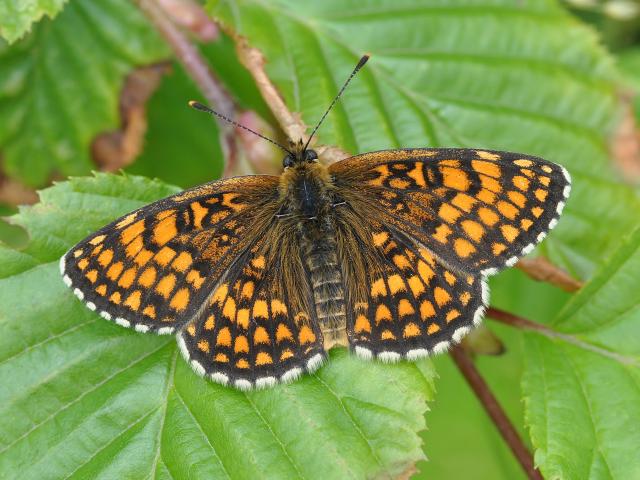The Heath Fritillary butterfly is one of our most threatened butterflies, being restricted to only four areas within the UK, namely the woodlands of Kent and Essex, Exmoor National Park in Somerset, and the Tamar Valley, where the population straddles the border between Devon and Cornwall. The total area occupied by this butterfly across all sites is less than 1 square kilometre, so it is a real priority for our conservation work.

The Heath Fritillary requires open moorland or woodland glades where its foodplants, Common Cow-wheat or Ribwort Plantain, are abundant. These conditions are usually created through coppicing, scrub management and ride-widening. Its preference for open, sunny glades in newly cleared woodland has led to its nickname ‘the Woodman’s follower’, as it traditionally followed the woodsman around a wood as new coppice clearings were created.
The Heath Fritillary was doing well in the Tamar Valley in the 1980s but by early 2000, following considerable growth by the conifers surrounding the site, much of the open habitat had become shaded with a reduction in the foodplant, which eventually led to the local extinction of the butterfly. Concerted conservation work was carried out to recreate suitable conditions and then the butterfly was re-introduced, in 2006.
Following the re-introduction, the population has remained stable thanks to the rotational programme of coppice management, ride management and bracken control, but additional areas need to be restored and connectivity improved between potential breeding areas in order to strengthen the population and help it to sustain in the long-term across the landscape.
Project Aim
The aim of the project is to restore additional areas of potential breeding habitat, enhance habitat quality across all sites and improve connectivity between them, providing a long term future for the butterfly. The project also aims to engage local people and volunteers, increasing understanding and appreciation of the butterfly and the landscape.
Project delivery period
July 2017 to December 2018
Methods
Potential sites are being surveyed for the butterfly and habitat suitability, and habitat management advice is being provided to land managers. Practical management work is being delivered to open up areas which were becoming shady and increase connectivity between potential habitat patches. Specifically, the project will:
- Survey six sites for presence of the Heath Fritillary butterfly and monitor for habitat quality, and foodplant abundance and presence
- Provide advice to land owners in how to manage for the butterfly’s needs
- Undertake 7 ha coppice restoration, planting oak/hazel saplings following felling of Larch conifer
- Undertake 2 ha coppicing at 3 sites
- Undertake 1.5 ha scrub removal at 3 sites
- Create a flower-rich field margin along 300m field boundary to create an appealing flight corridor and improve connectivity
- Work with volunteers from the Tamar Valley Trust as well as other local residents to undertake practical habitat management as well as record and survey for the butterfly.
Results
The butterfly monitoring data shows that the Heath Fritillary is already responding well, with higher timed counts recorded at Greenscombe Wood in 2017 and 2018 than in any year since the reintroduction. There is still a lot to do to restore the Tamar Valley sites, but we are hopeful that the work being undertaken to improve connectivity between potential breeding sites will enable the butterfly to spread more effectively and re-colonise nearby sites.
The positive partnership between landowners, Butterfly Conservation, Natural England, the Tamar Valley AONB and local farmers will continue with all organisations working together to maintain good conditions for the butterfly.
Funders
BIFFA Award for Biodiversity
Contact
Jenny Plackett, South West Regional Conservation Manager
Downloads
pdf 300.39 KB

